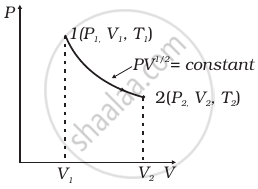Advertisements
Advertisements
प्रश्न
Consider a P-V diagram in which the path followed by one mole of perfect gas in a cylindrical container is shown in figure.

- Find the work done when the gas is taken from state 1 to state 2.
- What is the ratio of temperature T1/T2, if V2 = 2V1?
- Given the internal energy for one mole of gas at temperature T is (3/2) RT, find the heat supplied to the gas when it is taken from state 1 to 2, with V2 = 2V1.
उत्तर
Let `PV^(1/2) = K` = constant, `P = K/sqrt(V)`
Hence we can write, `P_1V_1^(1/2) = P_2V_2^(1/2) = K`
a. Work done for the process 1 to 2,
`W_(1 - > 2) int_(V_1)^(V_2) PdV`
= `int_(V_1)^(V_2) K/sqrt(V) dV`
= `K[sqrt(V)/(1/2)]_(V_1)^(V_2)`
= `2K(sqrt(V_2) - sqrt(V_1))`
= `2P_1V_1^(1/2) (sqrt(V_2) - sqrt(V_1))`
= `2P_2V_2^(1/2) (sqrt(V_2) - V_1)`
b. From the ideal gas equation,
`PV = nRT`
⇒ `T = (PV)/(nR)`
= `(Psqrt(V) sqrt(V))/(nR)`
⇒ `T = (Ksqrt(V))/(nR)` .....As, `P sqrt(V) = K`)
i.e., `T ∝ sqrt(V)`
Thus, `T_2/T_1 = sqrt(V^2/V_1)`
= `sqrt((2V_1)/V_1)`
= `sqrt(2)` .....(As V2 = 2V1)
c. Given, the internal energy of the gas, `U = (3/2) RT`
`ΔU = U_2 - U_1`
= `3/2 R(T_2 - T_1)`
= `3/2 R(sqrt(2)T_1 - T_1)`
= `3/2 RT_1(sqrt(2) - 1)` .....[∵ T2 = `sqrt(2)` T1 from (b)]
`ΔW = W_(1 -> 2)`
= `2P_1V_1^(1/2) (V_2^(1/2) - V_1^(1/2))`
= `2P_1V_1 (V_1^(1/2)/V_1^(1/2) - 1)`
= `2RT_1(sqrt(2) - 1)` ......`("As" P_1V_1 = RT_1 and V_2^(1/2)/V_1^(1/2) = sqrt(2))`
`ΔQ = ΔU + ΔW = 3/2 RT_1 (sqrt(2) - 1) + 2RT_1 (sqrt(2) - 1)`
= `7/2 RT_1 (sqrt(2) - 1)`
This is the amount of heat supplied.
APPEARS IN
संबंधित प्रश्न
A thermally insulated, closed copper vessel contains water at 15°C. When the vessel is shaken vigorously for 15 minutes, the temperature rises to 17°C. The mass of the vessel is 100 g and that of the water is 200 g. The specific heat capacities of copper and water are 420 J kg−1 K−1 and 4200 J kg−1 K−1 respectively. Neglect any thermal expansion. (a) How much heat is transferred to the liquid-vessel system? (b) How much work has been done on this system? (c) How much is the increase in internal energy of the system?
Answer the following in one or two sentences.
State the first law of thermodynamics.
ΔU is equal to ____________ work.
The compressibility of water is 5 × 10-10 m2/N. Pressure of 15 × 106 Pa is applied on 100 ml volume of water. The change in the volume of water is ______.
The process, in which no heat enters or leaves the system, is termed as ____________.
In a given process for an ideal gas, dW = 0 and dQ < 0. Then for the gas ____________.
In an adiabatic process, ______.
Explain the formulation of first law of thrmodynamics.
Obtain an expression for the workdone by a gas in an isothermal process.
Define the isothermal process.
